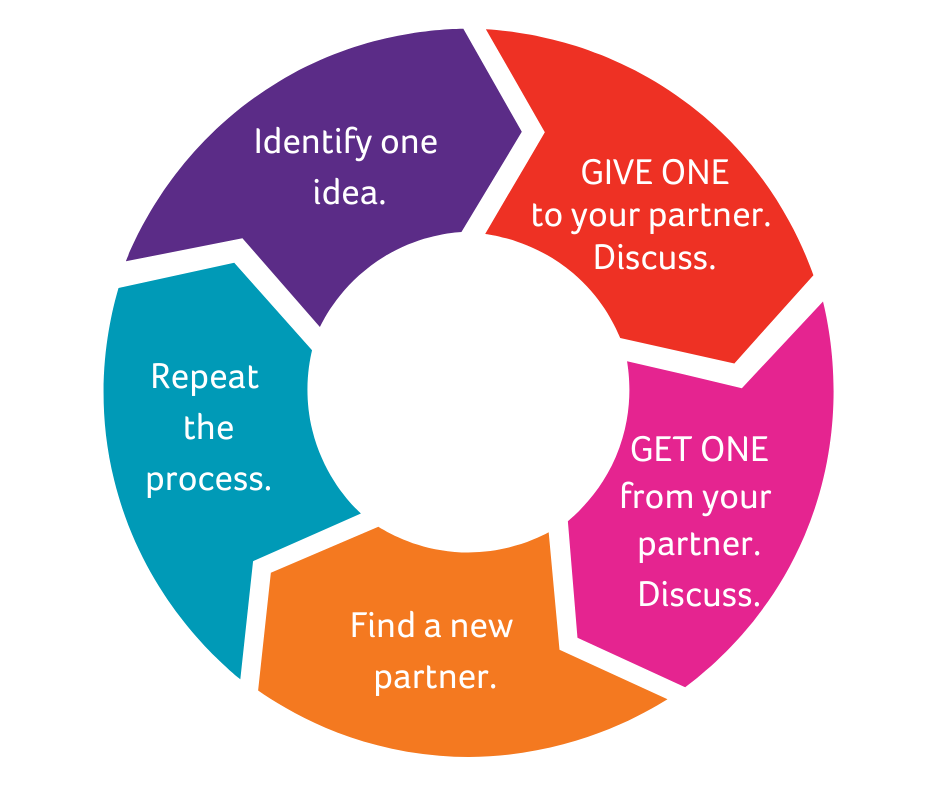STRATEGY FOCUS
Give One-Get One
PURPOSE
Give One-Get One is a strategy wherein students actively share information with each other. Students receive a question or prompt to which they respond in writing. The prompt could ask them to come up with ideas about a new topic, review the key concepts learned in a unit, or locate evidence directly from a text. Then, students share their thinking with multiple partners while also actively listening to the ideas of other students and writing those down. Through this structured process, students can test out, revise, and improve their initial ideas.

PROCESS
- Have students divide a sheet of paper into two columns and label the left side “Give One” and the right side “Get One.”
- Provide a prompt or ask a question. Students generate a specified minimum number of responses in the “Give One” column. They can write more than the minimum number of responses, and if they do, direct them to identify the most important or appropriate ones to start the activity with.
- Direct students to find a partner according to an established process (i.e., Clock Partners, Lock Partners). Have students identify Partner A and Partner B. Partner A shares first, while Partner B listens and adds new information to the “Get One” column.
- After a set amount of time, tell students to switch roles so that Partner B shares responses while Partner A listens for and records a new idea.
- Instruct students to find a new partner and repeat the process, continuing to listen for and record new ideas.
PROBING QUESTIONS
CONSIDERATIONS
- How did this process change your thinking about the question?
- Did you do an effective job communicating your ideas to others? If so, how do you know? If not, what could you do differently?
- After hearing the new ideas of your GOGO partners, were you more confident in your original response or did you see things from a new perspective?
- After completing the process, students could engage in additional Writing to Learn by summarizing their new learning or responding to some of their classmates’ ideas as an Exit Slip for the lesson.
- As the teacher circulates during the activity, it may be helpful to stop and give feedback to students on the process or to address misconceptions.
- Students can create their own template to use for Give One, Get One, or the teacher can provide an organizer.
CONTENT APPLICATIONS
![]()
SOCIAL STUDIES
After learning about the geography of the Nile River Delta, students brainstorm ideas about how that impacted the people in the region over time.
![]()
SCIENCE
After analyzing a data set and completing a see-think-wonder, students share one of their responses with partners.
![]()
WORLD LANGUAGES
To practice newly learned vocabulary for foods and beverages, students brainstorm in the target language things they would like to see served in the school cafeteria for lunch.
![]()
HEALTH & PHYSICAL EDUCATION
When studying influences, students list/share influences of family, peers, culture, media, technology and other factors on their own health behaviors.
Sources
Goalbook. (n.d.). Give One Get One. Goalbook toolkit. Retrieved February 8, 2022, from https://goalbookapp.com/toolkit/v/strategy/give-one-get-one.
Give One, get one. Facing History and Ourselves. (n.d.). Retrieved February 8, 2022, from https://www.facinghistory.org/resource-library/teaching-strategies/give-one-get-one.
